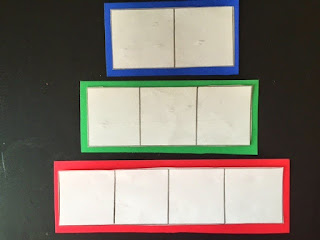Art
Cut notches in a paper plate. Children can weave yarn through the notches and then tie a ring to the end of the yarn.
*Children can also dip spiders and bats in paint and then use them like paint brushes.
Spider Puppet
You will need paper plates, construction paper, an old sock, markers, and a stapler to make this project. Decorate two plates to look like a spider’s body. Staple the plates together leaving an opening at the top and the bottom. Cut eight - 8” x 1” strips for the spider’s legs. Glue 4 legs on either side of the body. Draw a face on the sock and then stick it through the center of the plates.


*You can make a simple puppet for children by tying a spider ring to a piece of string or yarn.
Note! We used to have so much fun cooking in kindergarten. It was the highlight of Fabulous Friday every week. I know many of you are not allowed to do activities with food, and for some reason administrators don’t think there’s enough “rigor” in classroom cooking activities. Even if you can’t use these ideas in your classroom, you might be able to use them with your own children, grandchildren, a scout group, or even grownup friends!!!
Spider Soup
This was one of my favorite Halloween activities! Get a large industrial size can of chicken noodle soup. Remove the wrapper and cover with construction paper. Write “spider soup” on the label. Take two packages of ramen noodles and crush. Put in a paper lunch sack and write “spider webs” on the front of the sack. Explain to the children that you’ll be having spider soup for snack. Show them the can and just LISTEN to their comments. Open the can and put it in a crockpot. (Someone will be sure to comment that they see spider legs and meat!) Show them the sack and explain that you will end crunchy spider webs to make it better. Dump those in and slowly cook until it is warm. Serve in paper cups.
Spider Sandwich
Use a large plastic cup to cut a circle out of a piece of bread. Spread peanut butter, cream cheese, or Nutrella on the circle. Add eyes (raisins or chocolate chips), a mouth (M& M or cinnamon candy), and legs (pretzels, carrot sticks, or Cheetos).
*For a sweeter spider, put icing on a large sugar cookie and use licorice twists for legs.
Use a large plastic cup to cut a circle out of a piece of bread. Spread peanut butter, cream cheese, or Nutrella on the circle. Add eyes (raisins or chocolate chips), a mouth (M& M or cinnamon candy), and legs (pretzels, carrot sticks, or Cheetos).
*For a sweeter spider, put icing on a large sugar cookie and use licorice twists for legs.

Songs
Children can use spider rings to sing the “Itsy Bitsy Spider.” Sing “The BIG FAT Spider” with a loud voice. Sing the “Teensy Weensy Spider” with a high, squeaky voice.
Spider Dance
This is quite a challenge in coordination for young children! Everyone will need a partner. Partners stand side by side and put their inside arms around each other's back. Bring their free arm in front and challenge them to make the motions with their partner's free arm as you sing "The Itsy Bitsy Spider."
Spider Handshake
Partners extend 4 fingers and then touch fingertips as they wiggle their fingers.
Spider Applause
Tap fingertips together.
Nursery Rhyme
Let one child be little Miss Muffet. Tie a string to a spider ring and let another child dangle it as you say the rhyme.
Drop the Spider
This game can be played outside or inside. The children sit or stand in a circle. One child “it” takes a plastic spider and walks around the outside of the circle. “It” drops the spider behind one child. That child picks up the spider and chases “it” around the outside of the circle. “It” tries to get back to the spot first and sit down. The child holding the spider then becomes “it.”
















































